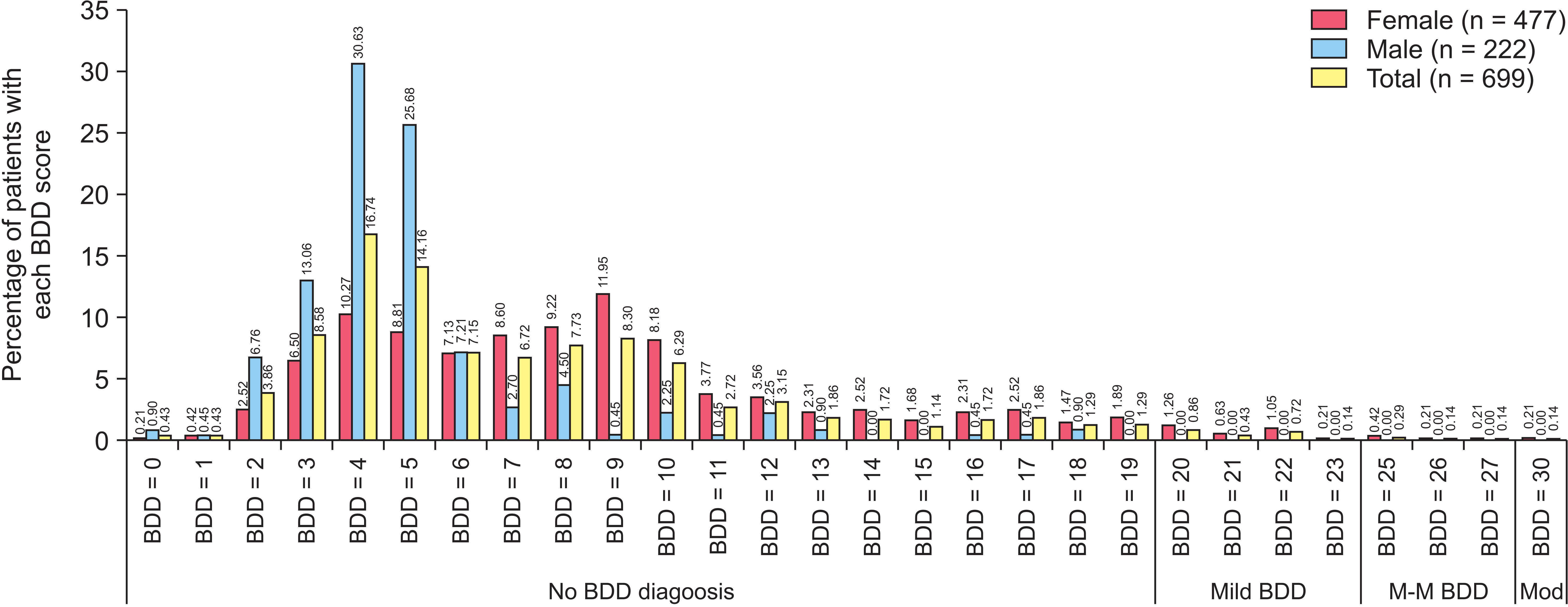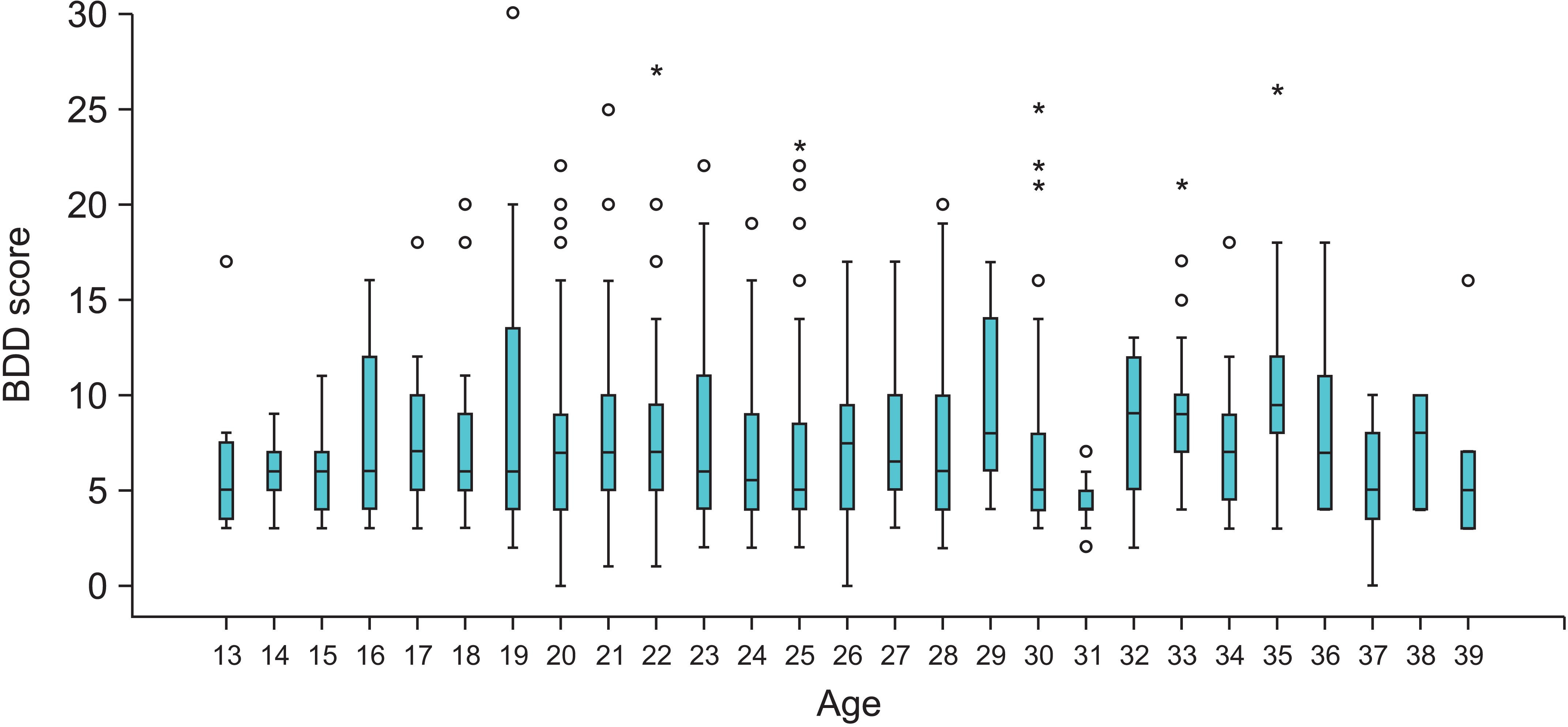Korean J Orthod.
2023 Jan;53(1):3-15. 10.4041/kjod22.155.
Associations between body dysmorphic disorder (BDD) with the dental health component of the index of orthodontic treatment need (IOTN-DHC) and other BDD risk factors in orthodontic patients: A preliminary study
- Affiliations
-
- 1Dental Research Center, Mazandaran University of Medical Sciences, Sari, Iran
- 2Orthodontic Department, Faculty of Dentistry, Mazandaran University of Medical Sciences, Sari, Iran
- 3Sexual and Reproductive Health Research Center, Addiction Institute, Mazandaran University of Medical Sciences, Sari, Iran
- 4Gastrointestinal Cancer Research Center, Non-communicable Diseases Institute, Mazandaran University of Medical Sciences, Sari, Iran
- 5Student Research Committee, Faculty of Dentistry, Mazandaran University of Medical Sciences, Sari, Iran
- 6Private Practice, Sari, Iran
- 7Department of Dental Anatomy, Dental School, Azad University of Medical Sciences, Tehran, Iran
- KMID: 2538709
- DOI: http://doi.org/10.4041/kjod22.155
Abstract
Objective
Body dysmorphic disorder (BDD) is a form of obsessive-compulsive disorder that may be negatively associated with the self-image. It might be associated with orthodontic treatment demand and outcome, and therefore is important. Thus, this study was conducted.
Methods
The Yale-Brown ObsessiveCompulsive Scale modified for Body Dysmorphic Disorder (BDD-YBOCS) questionnaire was used in 699 orthodontic patients above 12 years of age (222 males, 477 females), at seven clinics in two cities (2020–2021). BDD diagnosis and severity were calculated based on the first 3 items and all 12 items of the questionnaire. The dental health component of the index of orthodontic treatment need (IOTN-DHC) was assessed by orthodontists. Multivariable and bivariable statistical analyses were performed on ordinal and dichotomized BDD diagnoses to assess potentially associated factors (IOTN-DHC, age, sex, marital status, education level, and previous orthodontic consultation) (α = 0.05).
Results
IOTN-DHC scores 1–5 were seen in 13.0%, 39.9%, 29.8%, 12.4%, and 4.9% of patients. Age/sex/ marital status/education were not associated with IOTN-DHC (p > 0.05). Based on 3-item questionnaire, 17.02% of patients had BDD (14.02% mild). Based on 12-item questionnaire, 2.86% had BDD. BDD was more prevalent or severer in females, married patients, patients with a previous history of orthodontic consultation, and patients with milder IOTN-DHCs (p< 0.05).
Conclusions
IOTNDHC was negatively/slightly associated with BDD in orthodontic patients. Being female and married may increase BDD risk.
Keyword
Figure
Reference
-
1. Kerosuo H, Al Enezi S, Kerosuo E, Abdulkarim E. 2004; Association between normative and self-perceived orthodontic treatment need among Arab high school students. Am J Orthod Dentofacial Orthop. 125:373–8. DOI: 10.1016/j.ajodo.2003.04.009. PMID: 15014418.
Article2. Shue-Te Yeh M, Koochek AR, Vlaskalic V, Boyd R, Richmond S. 2000; The relationship of 2 professional occlusal indexes with patients' perceptions of aesthetics, function, speech, and orthodontic treatment need. Am J Orthod Dentofacial Orthop. 118:421–8. DOI: 10.1067/mod.2000.107008. PMID: 11029738.
Article3. Oshagh M, Salehi P, Pakshir H, Bazyar L, Rakhshan V. 2011; Associations between normative and self-perceived orthodontic treatment needs in young-adult dental patients. Korean J Orthod. 41:440–6. DOI: 10.4041/kjod.2011.41.6.440.
Article4. Momeni Danaie S, Asadi Z. 2003; Distribution of malocclusion types, hereditary crowding and the need of 7 9 year old children to serial extraction in Shiraz, 2000-2001. J Dent. 4:44–51.5. Proffit WR, Fields HW, Sarver DM. 2014. Contemporary orthodontics. 5th ed. Elsevier Health Sciences;New York:6. Shaw WC, Rees G, Dawe M, Charles CR. 1985; The influence of dentofacial appearance on the social attractiveness of young adults. Am J Orthod. 87:21–6. DOI: 10.1016/0002-9416(85)90170-8. PMID: 3855347.
Article7. Phillips B, Moulding R, Kyrios M, Nedeljkovic M, Mancuso S. 2011; The relationship between body dysmorphic disorder symptoms and self-construals. Clin Psychol. 15:10–6. DOI: 10.1111/j.1742-9552.2011.00004.x.
Article8. Sathyanarayana HP, Padmanabhan S, Balakrishnan R, Chitharanjan AB. 2020; Prevalence of Body Dysmorphic Disorder among patients seeking orthodontic treatment. Prog Orthod. 21:20. DOI: 10.1186/s40510-020-00322-8. PMID: 32743673. PMCID: PMC7396409. PMID: 41abd444497042d78cab47a501e24bf8.
Article9. Albino JE, Lawrence SD, Tedesco LA. 1994; Psychological and social effects of orthodontic treatment. J Behav Med. 17:81–98. DOI: 10.1007/BF01856884. PMID: 8201614.
Article10. Cunningham SJ, O'Brien C. 2007; Quality of life and orthodontics. Semin Orthod. 13:96–103. DOI: 10.1053/j.sodo.2007.03.005.
Article11. Schneider SC, Baillie AJ, Mond J, Turner CM, Hudson JL. 2018; The classification of body dysmorphic disorder symptoms in male and female adolescents. J Affect Disord. 225:429–37. DOI: 10.1016/j.jad.2017.08.062. PMID: 28858657.
Article12. Hepburn S, Cunningham S. 2006; Body dysmorphic disorder in adult orthodontic patients. Am J Orthod Dentofacial Orthop. 130:569–74. DOI: 10.1016/j.ajodo.2005.06.022. PMID: 17110253.
Article13. Avinash B, Avinash B, Shivalinga B, Jain S. 2013; Body dysmorphic disorder in orthodontic patients. World J Dent. 4:56–9. DOI: 10.5005/jp-journals-10015-1202.
Article14. Sadock BJ, Sadock VA, Ruiz P. 2017. Kaplan & Sadock's comprehensive textbook of psychiatry. 10th ed. Lippincott Williams & Wilkins;Philadelphia: DOI: 10.5005/jp-journals-10015-1202.15. Sadock BJ, Sadock VA, Kaplan HI. 2003. Kaplan & Sadock's synopsis of psychiatry. Vol 2:Lippincott Williams & Wilkins;Philadelphia: p. 277–8. DOI: 10.5005/jp-journals-10015-1202.16. Collins B, Gonzalez D, Gaudilliere DK, Shrestha P, Girod S. 2014; Body dysmorphic disorder and psychological distress in orthognathic surgery patients. J Oral Maxillofac Surg. 72:1553–8. DOI: 10.1016/j.joms.2014.01.011. PMID: 24582136.
Article17. Veale D, Gledhill LJ, Christodoulou P, Hodsoll J. 2016; Body dysmorphic disorder in different settings: a systematic review and estimated weighted prevalence. Body Image. 18:168–86. DOI: 10.1016/j.bodyim.2016.07.003. PMID: 27498379.
Article18. Yassaei S, Goldani Moghadam M, Aghili H, Tabatabaei SM. 2014; Body dysmorphic disorder in Iranian orthodontic patients. Acta Med Iran. 52:454–7. PMID: 25130153. PMID: c42d51655d98408e92c1e5974c7a527b.19. Polo M. 2011; Body dysmorphic disorder: a screening guide for orthodontists. Am J Orthod Dentofacial Orthop. 139:170–3. DOI: 10.1016/j.ajodo.2010.09.025. PMID: 21300244.
Article20. Bjornsson AS, Didie ER, Phillips KA. 2010; Body dysmorphic disorder. Dialogues Clin Neurosci. 12:221–32. DOI: 10.31887/DCNS.2010.12.2/abjornsson. PMID: 20623926. PMCID: PMC3181960.
Article21. Aouizerate B, Pujol H, Grabot D, Faytout M, Suire K, Braud C, et al. 2003; Body dysmorphic disorder in a sample of cosmetic surgery applicants. Eur Psychiatry. 18:365–8. DOI: 10.1016/j.eurpsy.2003.02.001. PMID: 14643566.
Article22. Tsakos G. 2008; Combining normative and psychosocial perceptions for assessing orthodontic treatment needs. J Dent Educ. 72:876–85. DOI: 10.1002/j.0022-0337.2008.72.8.tb04563.x. PMID: 18676796.
Article23. Asgari I, Ebn Ahmady A, Khoshnevisan MH, Eslamipour F. 2012; Evaluation of the patient-based indices for orthodontic need assessment in the 13 to 18 year-old adolescents in Isfahan. J Dent Med. 25:124–34.24. Rabiei M, Khormdel K, Kalantari K, Molavi H. 2010; Validity of the Yale-Brown obsessive compulsive scale modified for Body Dysmorphic Disorder (BDD) in students of the university of Isfahan. Iran J Psychiatry Clin Psychol. 15:343–50.25. Phillips KA, Hollander E, Rasmussen SA, Aronowitz BR, DeCaria C, Goodman WK. 1997; A severity rating scale for body dysmorphic disorder: development, reliability, and validity of a modified version of the Yale-Brown Obsessive Compulsive Scale. Psychopharmacol Bull. 33:17–22. PMID: 9133747.26. Phillips KA, McElroy SL, Dwight MM, Eisen JL, Rasmussen SA. 2001; Delusionality and response to open-label fluvoxamine in body dysmorphic disorder. J Clin Psychiatry. 62:87–91. DOI: 10.4088/JCP.v62n0203. PMID: 11247107. PMCID: PMC4096700.
Article27. Phillips KA. 2005. The broken mirror: understanding and treating body dysmorphic disorder. Oxford University Press;Oxford:28. Phillips KA, Menard W, Fay C, Weisberg R. 2005; Demographic characteristics, phenomenology, comorbidity, and family history in 200 individuals with body dysmorphic disorder. Psychosomatics. 46:317–25. DOI: 10.1176/appi.psy.46.4.317. PMID: 16000674. PMCID: PMC1351257.
Article29. Bordner MA. 2007. A cognitive-behavioral treatment program for body dysmorphic disorder. ProQuest;Michigan:30. Hassan AH. 2006; Orthodontic treatment needs in the western region of Saudi Arabia: a research report. Head Face Med. 2:2. DOI: 10.1186/1746-160X-2-2. PMID: 16420691. PMCID: PMC1360662.
Article31. Phillips KA. 2009. Understanding body dysmorphic disorder: an essential guide. Oxford University Press;Oxford:32. Soh J, Sandham A. 2004; Orthodontic treatment need in Asian adult males. Angle Orthod. 74:769–73. DOI: 10.1043/0003-3219(2004)074<0769:OTNIAA>2.0.CO;2. PMID: 15673139.33. Hamdan AM. 2004; The relationship between patient, parent and clinician perceived need and normative orthodontic treatment need. Eur J Orthod. 26:265–71. DOI: 10.1093/ejo/26.3.265. PMID: 15222710.
Article34. Souames M, Bassigny F, Zenati N, Riordan PJ, Boy-Lefevre ML. 2006; Orthodontic treatment need in French schoolchildren: an epidemiological study using the Index of Orthodontic Treatment Need. Eur J Orthod. 28:605–9. DOI: 10.1093/ejo/cjl045. PMID: 17095742.
Article35. Puertes-Fernández N, Montiel-Company JM, Almerich-Silla JM, Manzanera D. 2011; Orthodontic treatment need in a 12-year-old population in the Western Sahara. Eur J Orthod. 33:377–80. DOI: 10.1093/ejo/cjq086. PMID: 20926555.
Article36. Abu Alhaija ES, Al-Nimri KS, Al-Khateeb SN. 2005; Self-perception of malocclusion among north Jordanian school children. Eur J Orthod. 27:292–5. DOI: 10.1093/ejo/cjh094. PMID: 15947230.
Article37. Vulink NC, Rosenberg A, Plooij JM, Koole R, Bergé SJ, Denys D. 2008; Body dysmorphic disorder screening in maxillofacial outpatients presenting for orthognathic surgery. Int J Oral Maxillofac Surg. 37:985–91. DOI: 10.1016/j.ijom.2008.06.005. PMID: 18640822.
Article38. Phillips KA, Hollander E, Rasmussen SA, Aronowitz BR, DeCaria C, Goodman WK. 1997; A severity rating scale for body dysmorphic disorder: development, reliability, and validity of a modified version of the Yale-Brown Obsessive Compulsive Scale. Psychopharmacol Bull. 33:17–22. PMID: 9133747.39. Perugi G, Akiskal HS, Giannotti D, Frare F, Di Vaio S, Cassano GB. 1997; Gender-related differences in body dysmorphic disorder (dysmorphophobia). J Nerv Ment Dis. 185:578–82. DOI: 10.1097/00005053-199709000-00007. PMID: 9307620.
Article40. Biby EL. 1998; The relationship between body dysmorphic disorder and depression, self-esteem, somatization, and obsessive-compulsive disorder. J Clin Psychol. 54:489–99. DOI: 10.1002/(SICI)1097-4679(199806)54:4<489::AID-JCLP10>3.0.CO;2-B. PMID: 9623753.
Article41. Gupta R, Kaur S, Mahajan N, Kotwal B, Kharyal S, Gupta N. 2017; Prevalence of body dysmorphic disorder in adult Jammu population seeking orthodontic treatment. Int J Prev Public Health Sci. 3:25–7.42. Hollander E, Cohen LJ, Simeon D. 1993; Body dysmorphic disorder. Psychiatr Ann. 23:359–64. DOI: 10.3928/0048-5713-19930701-06. PMID: 27761054. PMCID: PMC5067103.
Article43. Phillips KA, McElroy SL, Hudson JI, Pope HG Jr. 1995; Body dysmorphic disorder: an obsessive-compulsive spectrum disorder, a form of affective spectrum disorder, or both? J Clin Psychiatry. 56 Suppl 4:41–51. discussion 52PMID: 7713865.44. Phillips KA, Diaz SF. 1997; Gender differences in body dysmorphic disorder. J Nerv Ment Dis. 185:570–7. DOI: 10.1097/00005053-199709000-00006. PMID: 9307619.
Article45. Koran LM, Abujaoude E, Large MD, Serpe RT. 2008; The prevalence of body dysmorphic disorder in the United States adult population. CNS Spectr. 13:316–22. DOI: 10.1017/S1092852900016436. PMID: 18408651.
Article
- Full Text Links
- Actions
-
Cited
- CITED
-
- Close
- Share
- Similar articles
-
- Associations between normative and self-perceived orthodontic treatment needs in young-adult dental patients
- A Preliminary Study for the Development of a Korean Version of the Body Dysmormphic Disorder Examination-Self Report(BDDE-SR)
- Development and Validation of the Expectations of Aesthetic Rhinoplasty Scale
- Psychosocial impact of malocclusion in Spanish adolescents
- Influence of Clinical Characteristics and Restriction Factors on Cooperation for Orthodontic Treatment in Adolescent Orthodontic Patients





